How Do You Test For PCB Exposure?
- Last Updated: July 14th, 2025

Attorney Jessie Paluch, founder of TruLaw, has over 25 years of experience as a personal injury and mass tort attorney, and previously worked as an international tax attorney at Deloitte. Jessie collaborates with attorneys nationwide — enabling her to share reliable, up-to-date legal information with our readers.
Legally Reviewed
This article has been written and reviewed for legal accuracy and clarity by the team of writers and legal experts at TruLawsuit Info and is as accurate as possible. This content should not be taken as legal advice from an attorney. If you would like to learn more about our owner and experienced injury lawyer, Jessie Paluch, you can do so here.
Fact-Checked
TruLawsuit Info does everything possible to make sure the information in this article is up to date and accurate. If you need specific legal advice about your case, contact our team by using the chat on the bottom of this page. This article should not be taken as advice from an attorney.
Key Takeaways:
- Blood tests are a primary method for detecting recent high-level PCB exposure, helping to assess health risks like cancer or liver damage.
- PCB testing can be conducted at certified labs, environmental health departments, occupational clinics, and sometimes through universities and state agencies.
- Early detection of PCB exposure is key in preventing long-term health effects and enables interventions to reduce further environmental contamination.
How Do You Test for PCB Exposure?
Question: How do you test for PCB exposure?
Answer: Tests are available to measure Polychlorinated Biphenyls (PCBs) in the blood, body fat, and breast milk, with a blood test being the most effective method for measuring exposure to large amounts of PCBs.
On this page, we’ll discuss this question in further depth, provide an overview of what PCB exposure is, the process of testing for PCB contaminants, and much more.
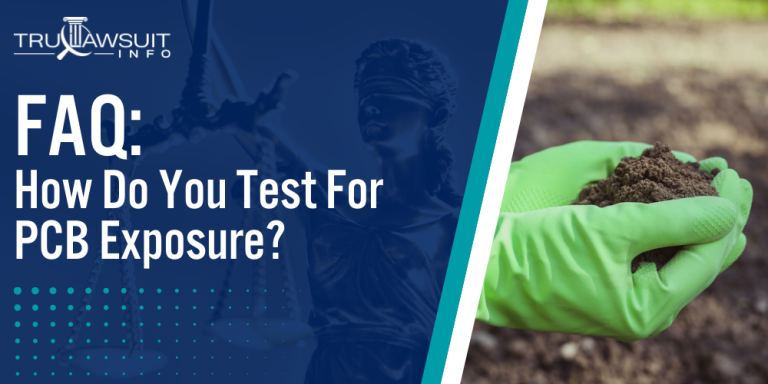
Intro to PCB Exposure
Testing for PCB exposure is essential to safeguarding human well-being and protecting the environment.
Additionally, indoor air can also be tested to determine if PCBs are present.
If you or a loved one has experienced adverse health conditions after being exposed to PCB chemicals, you may be eligible to pursue compensation.
Contact TruLawsuit Info today using the chat on this page to receive an instant case evaluation.
Table of Contents
Testing for PCB Exposure and Contamination
Polychlorinated biphenyls (PCBs) are environmental contaminants that can have serious health implications.
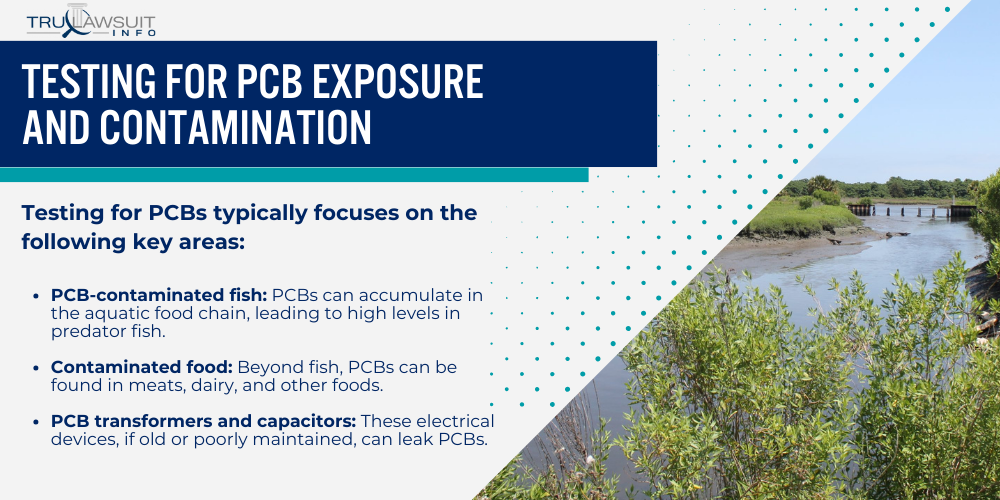
To manage and mitigate these risks, it’s crucial to understand the common sources and routes of PCB exposure, as well as the methodology for testing.
Common Sources of PCB Exposure
PCB exposure often stems from various contaminated sources, and identifying them is the first step in assessing risk.
Testing for PCBs typically focuses on the following key areas:
- PCB-contaminated fish: PCBs can accumulate in the aquatic food chain, leading to high levels in predator fish.
- Contaminated food: Beyond fish, PCBs can be found in meats, dairy, and other foods.
- PCB transformers and capacitors: These electrical devices, if old or poorly maintained, can leak PCBs.
- Improper disposal: PCBs persist in the environment due to inadequate disposal practices.
Routes of PCB Exposure
The way individuals come into contact with PCBs is critical in assessing exposure and designing appropriate tests.
Several primary routes of exposure stand out:
- Eating contaminated fish: Consuming foodstuffs tainted with PCBs is a significant exposure pathway, especially with certain fish.
- Breathing air near sources of PCB: Releases into the atmosphere from industrial sites can lead to inhalation risks.
- Using old electrical devices: Working with or handling old or malfunctioning PCB capacitors and transformers can expose individuals through skin contact or inhalation.
- Accidental ingestion: Although less common, accidental ingestion of PCB-contaminated materials can occur in various settings.
Health Risks of PCB Exposure
Polychlorinated biphenyls (PCBs) represent a group of cancer-causing chemicals associated with a spectrum of health effects.
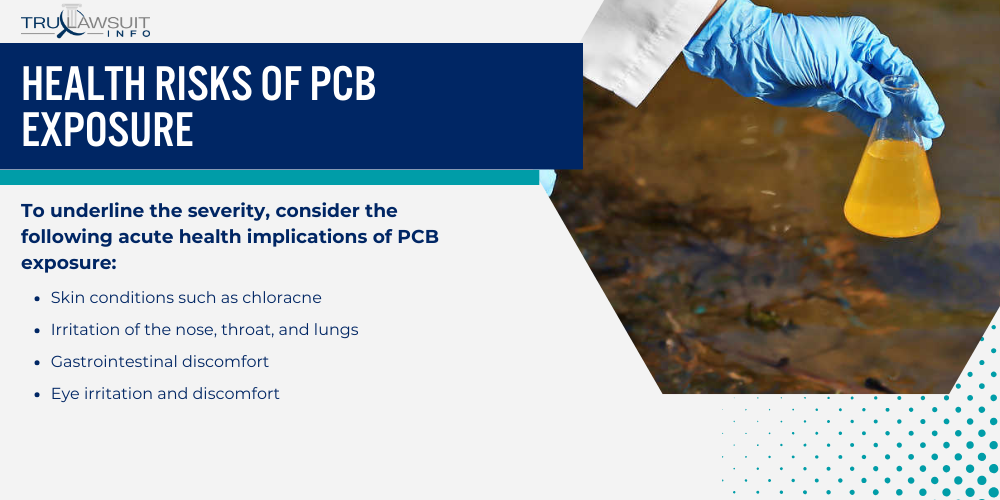
PCBs affect human health through both immediate toxic effects and long-term chronic health issues.
Acute Toxic Effects
Acute toxic effects are the immediate health repercussions observed after short-term PCB exposure.
These can vary in severity based on the exposure level and the immune system response of the individual.
To underline the severity, consider the following acute health implications of PCB exposure:
- Skin conditions such as chloracne
- Irritation of the nose, throat, and lungs
- Gastrointestinal discomfort
- Eye irritation and discomfort
Chronic Health Effects
Long-term or repeated exposure to PCBs has been linked to lasting adverse health effects.
Numerous studies have substantiated that PCBs are probable human carcinogens.
The chronic health effects associated with PCB exposure include:
- Potential increased risk of developing cancer, including liver cancer, brain cancer, and breast cancer
- Disruption of thyroid hormones, which are critical for metabolism and growth
- Weakening of the immune system, making the body more susceptible to diseases
- Possible reproductive health issues impacting both fertility and child development
Diagnosis and Testing: PCB Chemicals
Diagnostic testing usually involves blood tests to assess exposure to polychlorinated biphenyls (PCBs) and may be supported by other methods to measure PCB levels in various body tissues.
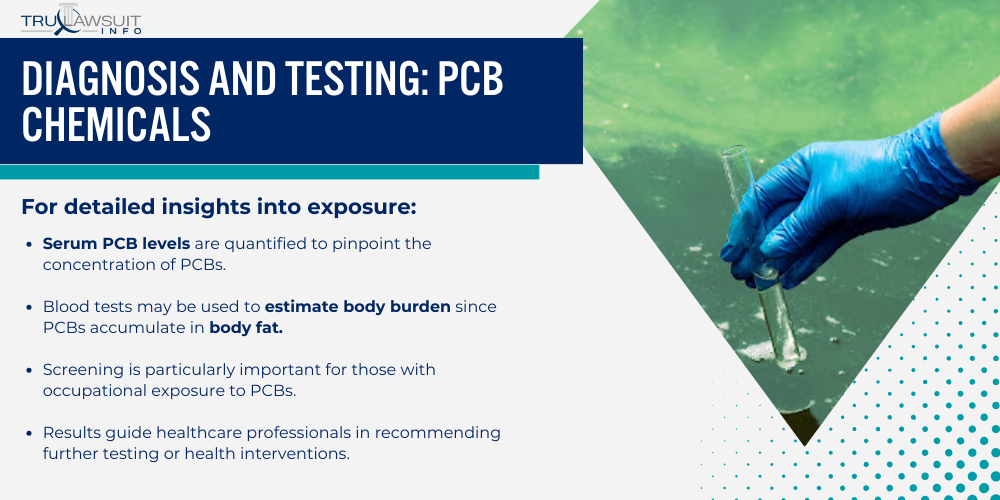
Blood Tests for PCBs
Blood tests are a common starting point for diagnosing PCB exposure.
They measure the levels of PCBs in the blood, which reflect recent exposure.
For detailed insights into exposure:
- Serum PCB levels are quantified to pinpoint the concentration of PCBs.
- Blood tests may be used to estimate body burden since PCBs accumulate in body fat.
- Screening is particularly important for those with occupational exposure to PCBs.
- Results guide healthcare professionals in recommending further testing or health interventions.
Other Diagnostic Methods
Doctors use various methods to detect PCB exposure besides standard blood analysis.
These approaches help paint a full picture of how these chemicals affect the body.
Aside from blood tests, a range of diagnostic tools are employed to garner a comprehensive understanding of PCB exposure:
- Tests on body fat samples can provide information on long-term exposure to PCBs, as these compounds are lipophilic and accumulate in adipose tissue.
- Breast milk testing is utilized to assess exposure in nursing infants.
- Liver function tests aid in detecting potential damage from PCBs, as the liver is a primary organ affected by toxic substances.
- Diagnostic imaging may be indicated if there is a concern for specific organ damage due to PCB exposure.
Regulations and Safety Guidelines for PCBs
Regulations concerning polychlorinated biphenyls (PCBs) are critical to protecting both environmental health and public safety.
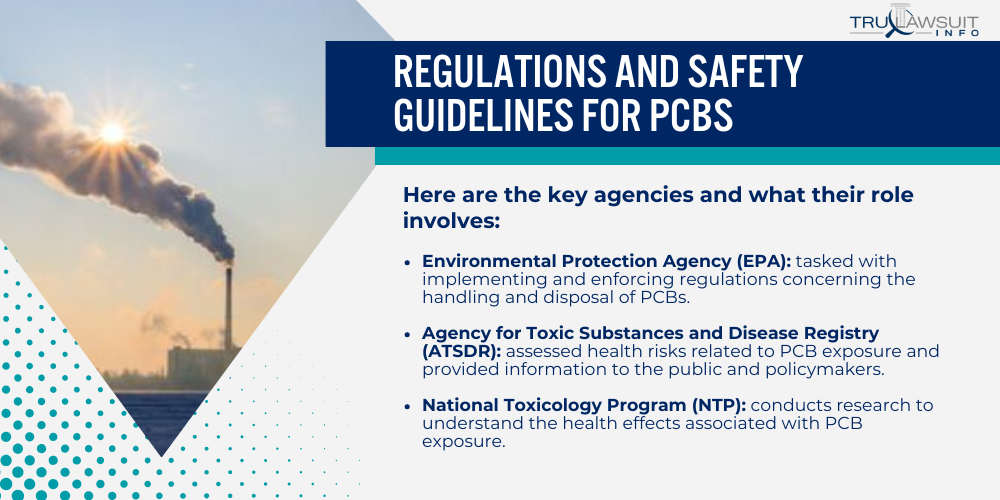
These guidelines limit human exposure, which can occur through eating contaminated food or its release into the environment.
Agency Involvement
Several agencies are pivotal in overseeing and regulating PCBs to safeguard public health and the environment.
Here are the key agencies and what their role involves:
- Environmental Protection Agency (EPA): tasked with implementing and enforcing regulations concerning the handling and disposal of PCBs.
- Agency for Toxic Substances and Disease Registry (ATSDR): assessed health risks related to PCB exposure and provided information to the public and policymakers.
- National Toxicology Program (NTP): conducts research to understand the health effects associated with PCB exposure.
- U.S. Food and Drug Administration (FDA): ensures that PCB levels in food are monitored and controlled to prevent entry into the food chain.
- Department of Health and Human Services (HHS): works broadly to protect health, including efforts to minimize exposure to toxic substances like PCBs.
Safety Standards
Efforts to establish safety standards for PCBs entail setting maximum permissible levels in various environments and products.
The following criteria have been established to ensure public safety and environmental health:
- Maximum Allowable Levels in Air: Strict limits are established for PCB concentration in ambient air to minimize inhalation exposure risks.
- Acceptable Levels in Water: The EPA sets limits for PCBs in surface water to protect aquatic life and reduce risks associated with water consumption.
- Food Contamination Limits: The EPA and FDA collaborate to establish the maximum PCB levels allowed in food products, particularly fish and seafood.
- Occupational Exposure Limits: Guidelines for workers handling PCBs aim to protect against chronic exposure in industrial or remediation settings.
- Waste Management Standards: Regulations stipulate safe processing, storage, and disposal of PCB-containing materials to prevent environmental contamination.
- Remediation Thresholds: The EPA provides guidance for cleaning up sites contaminated with PCBs, emphasizing the restoration of safe conditions.
Environmental and Occupational Impact of PCBs
Polychlorinated biphenyls (PCBs) are industrial chemicals that have profound effects on both wildlife and ecosystems, as well as on individuals who are exposed in the workplace.
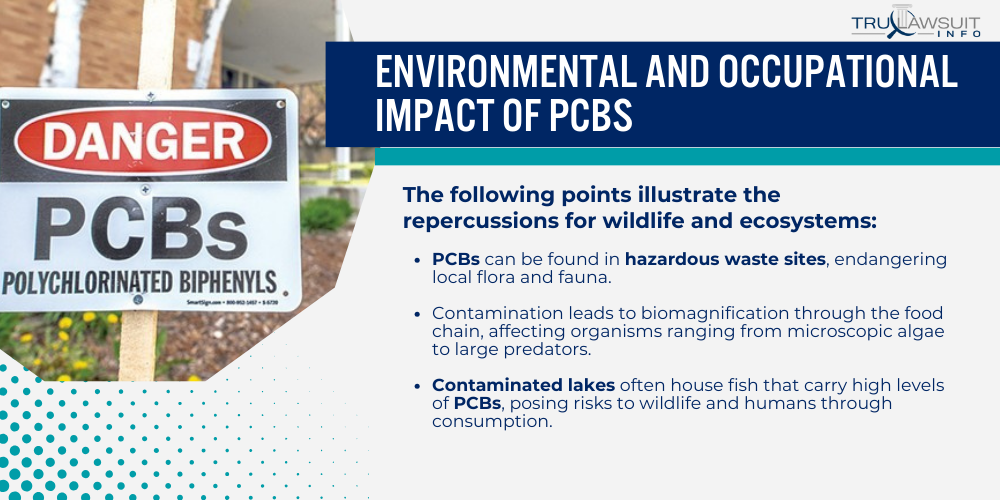
This section explores the complexities of PCB exposure from environmental contamination to occupational hazards.
Wildlife and Ecosystems
Harmful consequences of PCB pollution are particularly evident in contaminated lakes and PCB-contaminated waters.
The substances have a long-lasting impact due to their persistence and bioaccumulation in the environment.
The following points illustrate the repercussions for wildlife and ecosystems:
- PCBs can be found in hazardous waste sites, endangering local flora and fauna.
- Contamination leads to biomagnification through the food chain, affecting organisms ranging from microscopic algae to large predators.
- Contaminated lakes often house fish that carry high levels of PCBs, posing risks to wildlife and humans through consumption.
- Birds of prey and mammalian predators can suffer from reproductive issues and weakened immunity due to PCB exposure.
Workers’ Exposure
Individuals working with or around PCBs, such as in factories that handle electrical transformers or repair old fluorescent lighting fixtures, are at particular risk of exposure.
Exposed workers are often monitored for PCB exposures to prevent the associated health risks:
- Protective measures are essential in workplaces where PCBs are handled or where old fluorescent lighting fixtures are likely to be encountered.
- Regular screening is conducted to ensure that exposed workers do not carry high body burdens of PCBs.
- Industries that involve the manufacture or repair of electrical transformers are hotspots for potential worker exposure.
- Disposal and maintenance protocols are critical in preventing PCB exposure in occupations related to waste management of hazardous materials.
Mitigating Exposure to PCBs
Mitigating exposure to PCBs is essential for reducing health risks from these toxic substances, which are often encountered in hazardous waste sites and older buildings.
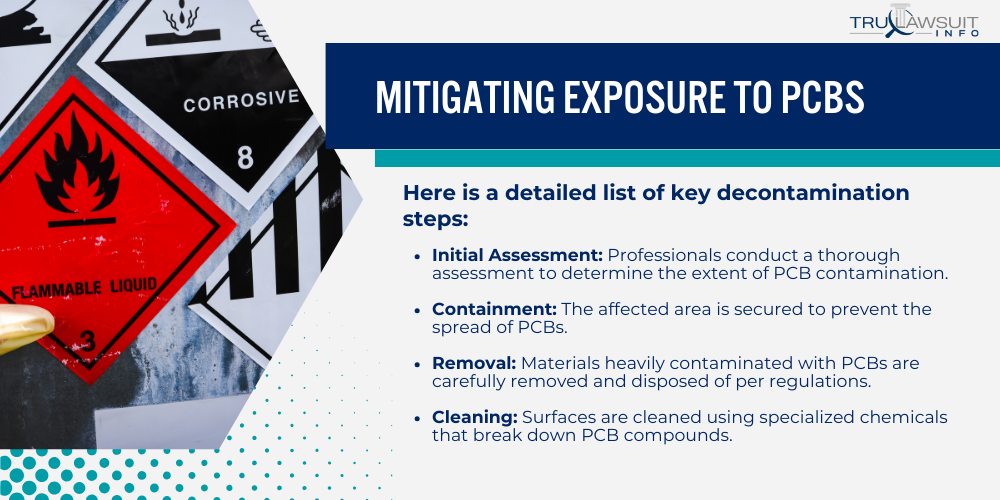
The following strategies are crucial for addressing and preventing unnecessary contact with PCBs, whether in the environment or in occupational settings recognized by international agencies monitoring PCB levels.
Decontamination Processes
Decontamination of PCBs typically involves a series of steps designed to thoroughly remove or reduce PCB contamination in environments where these substances are present.
Decontamination can be complex, depending on the extent and location of the contamination.
Here is a detailed list of key decontamination steps:
- Initial Assessment: Professionals conduct a thorough assessment to determine the extent of PCB contamination.
- Containment: The affected area is secured to prevent the spread of PCBs.
- Removal: Materials heavily contaminated with PCBs are carefully removed and disposed of per regulations.
- Cleaning: Surfaces are cleaned using specialized chemicals that break down PCB compounds.
- Verification: Post-decontamination testing ensures all PCBs have been adequately removed from the site.
- Maintenance: Regular monitoring and maintenance are conducted to prevent recontamination.
Prevention Strategies
Prevention strategies involve avoiding the release and spread of PCBs, as well as reducing exposure to areas known to contain these substances.
Preventive measures are crucial, especially considering PCBs’ persistence in the environment and potential accumulation in living organisms.
The following are proactive measures to minimize PCB exposure:
- Regulatory Compliance: Ensuring all activities are in line with the guidelines provided by international and local agencies.
- Proper Disposal: Using approved methods for disposing of PCB-containing materials to avoid environmental contamination.
- Material Replacement: Where possible, replace materials known to contain PCBs with safer, PCB-free alternatives.
- Public Education: Informing communities and workers about the dangers of PCBs and ways to reduce exposure.
- Occupational Safety: Implementing workplace safety programs and providing protective gear to those who work with or around PCBs.
- Environmental Monitoring: Conduct regular environmental monitoring to detect and address new areas of PCB contamination.
PCBs in Consumer Products
Polychlorinated biphenyls, or PCBs, were once widely used in consumer products for their chemical stability and insulating properties.
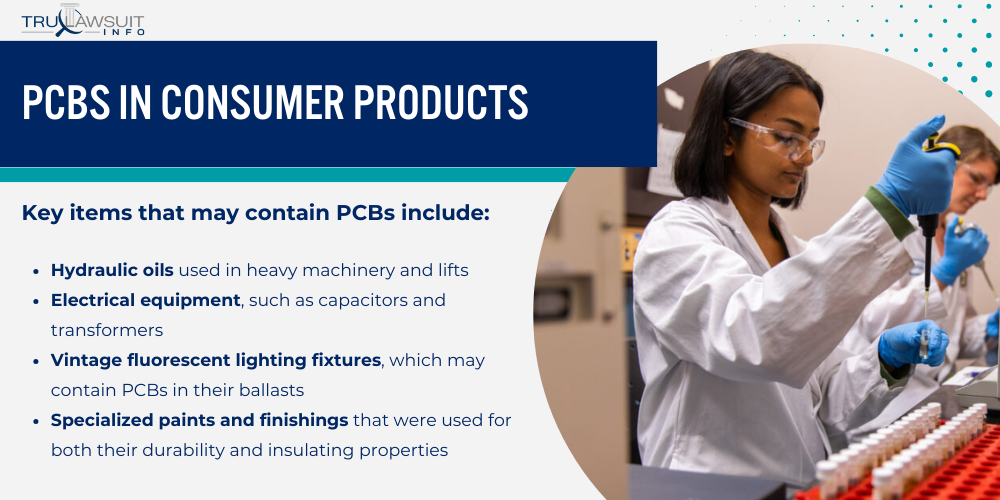
Although banned since the late 1970s, they can still be found in older items and certain environments.
Identifying PCB Products
PCBs were commonly used in various industrial and consumer products.
One key factor in assessing PCB exposure is identifying which products may contain these chemicals.
Key items that may contain PCBs include:
- Hydraulic oils used in heavy machinery and lifts
- Electrical equipment, such as capacitors and transformers
- Vintage fluorescent lighting fixtures, which may contain PCBs in their ballasts
- Specialized paints and finishings that were used for both their durability and insulating properties
Risk of PCBs in Vintage Items
Older products pose a significant risk for PCB exposure, especially if they have not been properly disposed of or have broken down over time.
Risks associated with PCBs in vintage products:
- Fish consumption from contaminated waters, like Lake Michigan, where PCBs accumulate over time in the tissues of fish
- Consumption of dairy products and other animal-derived foods is a potential pathway through which PCBs can enter the human body.
- Using rice oil contaminated with PCBs, as experienced in some historical mass poisonings
- Lower birth weight can be an outcome of prenatal exposure to high levels of PCBs, relating PCB congener specificity to particular health effects.
TruLawsuit Info: #1 PCB Exposure Lawyers
TruLaw is a law firm renowned for its expertise in handling cases related to PCB exposure.
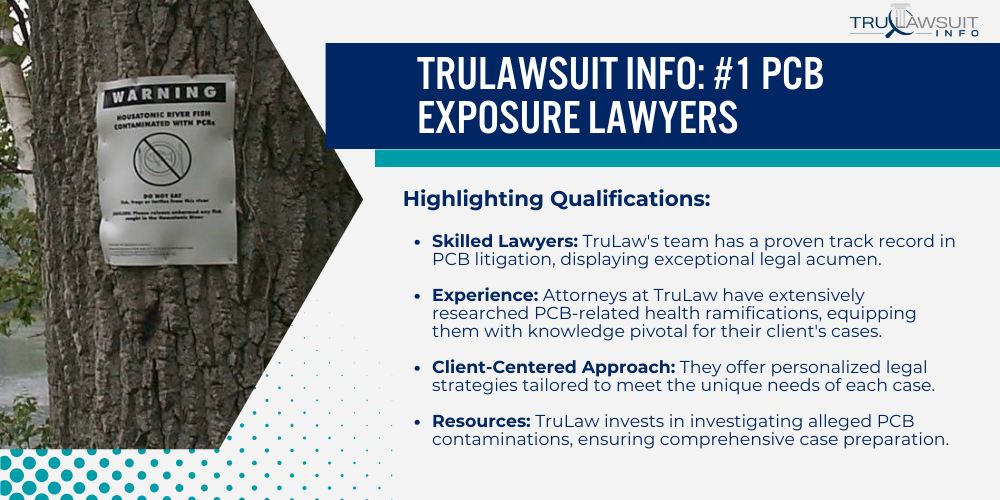
With an experienced team of attorneys, TruLaw has established itself as a leading advocate for individuals adversely affected by PCBs.
Highlighting Qualifications:
- Skilled Lawyers: TruLaw’s team has a proven track record in PCB litigation, displaying exceptional legal acumen.
- Experience: Attorneys at TruLaw have extensively researched PCB-related health ramifications, equipping them with knowledge pivotal for their client’s cases.
- Client-Centered Approach: They offer personalized legal strategies tailored to meet the unique needs of each case.
- Resources: TruLaw invests in investigating alleged PCB contaminations, ensuring comprehensive case preparation.
Providing trusted legal representation, TruLaw lawyers understand the complexities of environmental law and the nuances of toxic exposure cases.
Their dedication is evidenced by their methodical approach to dealing with PCB exposure cases, which includes:
- Gathering compelling evidence linking PCB exposure to health issues.
- Consulting with leading health experts and toxicologists.
- Navigating through complex regulatory environments.
- Determining the most effective course of legal action for their clients.
Frequently Asked Questions
-
What are common symptoms indicating exposure to PCBs?
Individuals exposed to PCBs may experience a range of symptoms, including skin conditions such as chloracne and rashes, as well as neurological problems like cognitive deficiencies.
Prolonged PCB exposure may also lead to reproductive issues and issues in the immune system.
-
In what ways can PCB levels be measured in the body?
Measurement of PCB levels in the human body primarily involves blood tests where the serum congener profiles are analyzed.
Healthcare professionals might also use tissue sampling and breast milk analysis to determine the PCB burden in newborns.
-
What methods are employed to detect PCB contamination in water?
To detect PCBs in water, a multi-step approach is typically followed: first, water samples are collected; then, solid-phase extraction is employed to concentrate the PCBs, followed by gas chromatography for separation; and finally, mass spectrometry for identification and quantification.
-
What are the standard procedures for assessing PCBs in oil samples?
To assess PCB concentrations in oil samples, techniques such as gas chromatography equipped with an electron capture detector may be used to isolate and measure specific PCB congeners.
Oil samples are often required to be meticulously cleaned up to remove any interfering substances before testing.
-
How do healthcare professionals generally treat exposure to PCBs?
Treatment for PCB exposure includes supportive care and interventions focused on reducing symptoms.
Sometimes, healthcare providers administer medication to address skin conditions or advise patients to avoid further exposure to PCBs.
Continuous monitoring may also be necessary for those experiencing chronic health effects.
-
Can PCBs be effectively cleared from the human body, and if so, how?
Clearing PCBs from the human body is challenging due to their tendency to accumulate in fat tissues.
However, interventions like dietary modifications to reduce fat intake and boost metabolism might slightly reduce PCB levels over time.
Complete elimination, though, is typically not possible.

Experienced Attorney & Legal SaaS CEO
With over 25 years of legal experience, Jessie is an Illinois lawyer, a CPA, and a mother of three. She spent the first decade of her career working as an international tax attorney at Deloitte.
In 2009, Jessie co-founded her own law firm with her husband – which has scaled to over 30 employees since its conception.
In 2016, Jessie founded TruLaw, which allows her to collaborate with attorneys and legal experts across the United States on a daily basis. This hypervaluable network of experts is what enables her to share reliable legal information with her readers!
Have A Case?
Here, at Tru Lawsuit Info, we’re committed to helping victims get the justice they deserve.
To do this, we actively work to connect them with attorneys who are experts in litigating cases similar to theirs.
Would you like our help?
Tru Lawsuit Info is a reliable source of information about issues that may affect your health and safety, such as faulty products, data breaches, and environmental hazards.
Our team of experienced writers collaborates with medical professionals, lawyers, and advocates to produce informative articles, guides, and other resources that raise awareness of these topics.
Our thorough research provides consumers with access to reliable information and updates on lawsuits happening around the country. We also can connect consumers with attorneys if they need assistance.
Camp Lejeune's water contamination issue spanned several decades starting in the 1950s. Exposure to these chemicals has been linked to various serious health issues, including cancer, organ diseases, and death.
Research is increasingly suggesting a link between the use of Tylenol during pregnancy and the development of neurodevelopmental disorders, such as autism and ADHD, in infants.
Legal action is being taken against manufacturers of Aqueous Film-Forming Foam (AFFF), a chemical used in fighting fires. The plaintiffs allege that exposure to the foam caused health issues such as cancer, organ damage, and birth and fertility issues.
Have A Case?
Here, at Tru Lawsuit Info, we’re committed to helping victims get the justice they deserve.
To do this, we actively work to connect them with attorneys who are experts in litigating cases similar to theirs.
Would you like our help?







